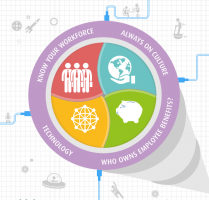August 24, 2015
Flexible working now an almost universal employee benefit, claims study 0
 A new report from employee benefits provider Unum claims to set out the future trends and challenges affecting the benefits packages firms should offer staff. One of the headline claims from the report is that four out of five employers (79 percent) already offer flexible working. ‘The Future of Employee Benefits’ report surveyed 13 organisations and incorporated the results with those of a series of interviews and roundtable discussions with employers and specialists including representatives from the Chartered Institute of Personnel and Development. The report identifies a series of macro trends affecting workplace wellbeing and the recruitment and retention of employees over the next 15 years, which were categorised into four distinct working environments: The Ageless Workplace; The Mindful Workplace; The Intuitive Workplace; and The Collaborative Workplace.
A new report from employee benefits provider Unum claims to set out the future trends and challenges affecting the benefits packages firms should offer staff. One of the headline claims from the report is that four out of five employers (79 percent) already offer flexible working. ‘The Future of Employee Benefits’ report surveyed 13 organisations and incorporated the results with those of a series of interviews and roundtable discussions with employers and specialists including representatives from the Chartered Institute of Personnel and Development. The report identifies a series of macro trends affecting workplace wellbeing and the recruitment and retention of employees over the next 15 years, which were categorised into four distinct working environments: The Ageless Workplace; The Mindful Workplace; The Intuitive Workplace; and The Collaborative Workplace.
































August 17, 2015
What Edward T Hall (and Jerry Seinfeld) can teach us about stress and design
by Mark Eltringham • Comment, Facilities management, Workplace, Workplace design
Work-related stress is the biggest cause of working days lost in the UK. According to the HSE’s most recent statistics, around 11.3 million days were lost to it in 2013/14, the most significant cause of absenteeism. The reasons for this are clear in the minds of many: the demands made on us by employers are increasingly intolerable, our own time is being eroded by work, we spend too much time at work, we’re under excessive pressure to perform and as a result we’re all either knackered, unfulfilled, stressed, depressed or anxious. Or guzzling a noxious cocktail of all of them. But there is another factor that has come into play over the last few years. As workstation sizes have contracted in response to new technologies and new space planning models, people have been forced closer to their colleagues, meaning that not only has their time been eroded, so has their space.
More →